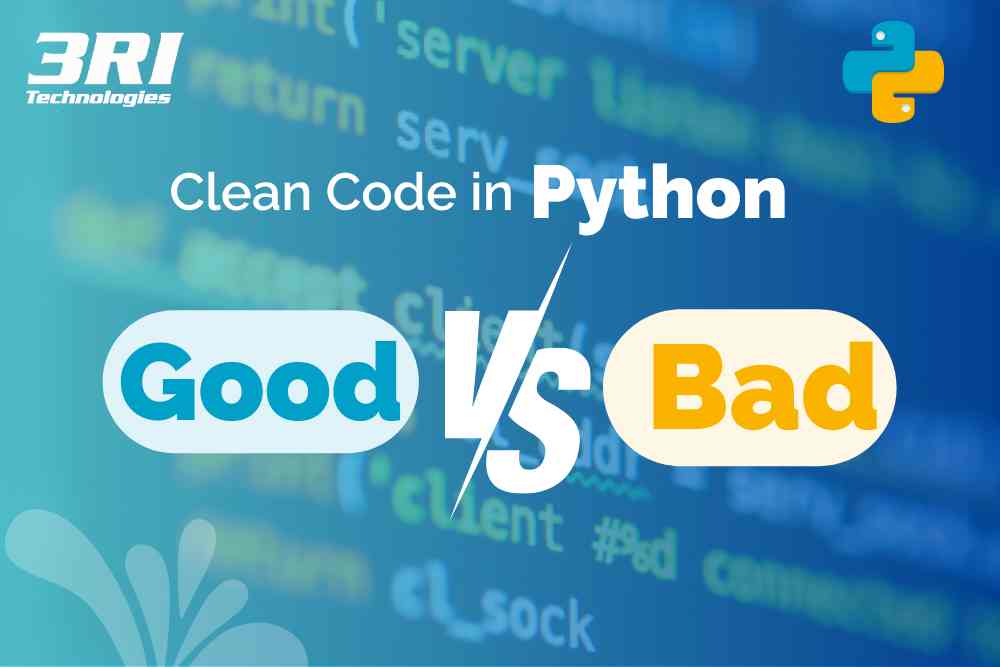Introduction
At 3RI Technologies, we understand the importance of writing clean, maintainable code. Especially in Python, a language known for its readability, upholding good coding practices becomes essential for long-term project success. This blog post dives into the concept of clean code in Python, explores the key differences between good and bad code, and provides illustrative examples to solidify your understanding.
Writing clean code is more than formatting—it reflects clarity, performance, and long-term maintainability. This guide covers essential good code practices in Python, emphasizing how to create cleaner code, perform with a code review checklist, and avoid common mistakes. If you’re serious about learning how to code in Python effectively, these principles are non-negotiable. At 3RI Technologies, our Python Full Stack Developer Course dives deep into real-world, clean coding techniques to shape you into a job-ready developer. Make your code readable, scalable, and professional with practices that truly make a difference.
What is Clean Code?
Clean code is a set of principles aimed at creating well-structured, readable, and maintainable code. It puts efficiency and clarity first, making it simpler for developers—including you—to understand, change, and evolve the codebase in the future. Clean code isn’t just about aesthetics; it is about creating code that functions effectively and can evolve alongside your project’s needs.

Master Cleaner Code with Proven Python Practices
Here are some key reasons why writing clean code is crucial for Python projects:
- Readability: Clean code is easily understandable for both you and other developers. This reduces the time spent deciphering complex logic, ultimately saving time and resources during maintenance and collaboration.
- Maintainability: Clean code is easier to modify and adapt as your project’s requirements change. With clear structure and well-defined functions, you can introduce new features or fix bugs without wrestling with tangled code.
- Fewer Errors: Clean code is less prone to errors due to its clarity and focus on logic. This translates to fewer debugging headaches and a more robust codebase.
- Teamwork: Clean code fosters better collaboration within development teams. When everyone can understand the code’s intent, communication becomes smoother and knowledge transfer is simplified. Check out the Python Training in Pune..
Code Principles
Several key principles guide the creation of clean code in Python:
- Meaningful Names: Use descriptive variable and function names that clearly convey their purpose. Avoid unclear abbreviations and single-letter names.
- Single Responsibility Principle: Each function or class should handle a single, specific responsibility. This improves modularity and makes the code easier to understand and test.
- Don’t Repeat Yourself (DRY): Prevent code duplication by using functions and classes to encapsulate reusable functionalities.
- Comments (Sparingly): While comments can be helpful for complex logic, strive for self-documenting code through clear variable names and well-structured functions. Excessive comments can become outdated and clutter the code.
- Proper Formatting: Consistent indentation and spacing improve readability. Utilize tools like linters and code formatters to enforce consistent formatting throughout your project.
Good Code Versus Bad Code?
Let’s delve into the practical differences between good and bad code in Python through a table with illustrative examples:
| Feature | Good Code | Bad Code |
| Readability | Uses clear and descriptive variable names that accurately reflect their purpose (e.g., total_cost instead of tc). Consistent indentation and spacing improve readability. | Relies on abbreviations, single-letter names (e.g., l, w), or cryptic names that don’t convey meaning. Inconsistent formatting makes the code harder to follow. |
| Maintainability | Ensure modularity with smaller, well-defined functions that are easier to understand and modify. Each function should follow the Single Responsibility Principle, having a single, well-defined purpose. | Understanding and modifying large functions can be difficult. Functions might try to do multiple things, making them harder to maintain. |
| Scalability | Designed for future growth with reusable functions and classes. Loose coupling allows for changes in one part without affecting others. | Difficult to scale as the project grows. Tight coupling leads to widespread impact from changes in one part of the code Top of Form Bottom of Form |
| Logic | Functions have a clear purpose and perform one specific task. They avoid side effects like modifying global variables or printing output. | Functions have unclear purposes and might perform multiple tasks or have unintended side effects. |
| Complexity | Well-structured and easy to follow. Uses clear logic without unnecessary complexity like nested loops or overly complex calculations. | Can be convoluted with nested loops, redundant calculations, or unnecessary steps, making it difficult to understand and debug. |
Good Code is Readable
In the realm of Python programming, clean code isn’t just about functionality; it is about crafting code that thrives in the long run. Readability forms the cornerstone of clean code, ensuring clarity and maintainability.
Here is why readability matters:
- Reduced Cognitive Load: Imagine inheriting a project with cryptic code. Deciphering its logic becomes a mental burden. Readable code, on the other hand, uses clear and descriptive names (think “calculate_total_cost” instead of “calc_cost”). This lessens the cognitive burden for both you and fellow developers, simplifying comprehension of the code’s intent and operations.
- Enhanced Collaboration: When everyone can readily grasp the code’s intent, collaboration flourishes. Developers can seamlessly contribute, debug, and extend the codebase without getting lost in a maze of obscurity. Imagine a well-written instruction manual for assembling furniture – it fosters smooth collaboration!
- Faster Debugging: Debugging convoluted code is akin to searching for a needle in a haystack. Readable code, with its clear structure and descriptive names, simplifies the process of pinpointing the source of errors. This translates to faster debugging cycles and quicker problem-solving.
- Reduced Maintenance Costs: Crystal-clear code translates to less time spent deciphering complex structures during maintenance. Efficient modifications and updates save precious time and resources for you and your team.
By prioritizing readability, you invest in the future health of your Python project. Clear code fosters better understanding, collaboration, and maintainability, ultimately leading to a robust and sustainable codebase. Explore further with our Python Web Development Course to deepen your knowledge and skills.

Good Code is Scalable
Clean code in Python isn’t just about functionality today; it is about building code that adapts and thrives as your project grows. Scalability sits at the heart of this philosophy, ensuring your codebase remains robust and adaptable in the face of future changes.
Here is how scalable code is achieved:
- Modular Design: Imagine building with Lego blocks – each piece has a specific purpose, and they can be combined to create complex structure. Scalable code follows a comparable strategy. By decomposing intricate logic into smaller, reusable functions and classes, you establish modular components. These units can be easily combined and reused for new features or functionalities, promoting scalability.
- Single Responsibility Principle: This principle stipulates that each function or class should serve a singular, clearly defined purpose. Imagine a single tool trying to do everything – a screwdriver hammering nails! It is inefficient. Scalable code promotes focused functionalities, making it easier to understand, modify, and adapt individual parts without impacting the entire system.
- Loose Coupling: Tightly coupled code, where changes in one part ripple through the entire system, can be a scalability nightmare. Scalable code strives for loose coupling, where components are more independent. This allows modifications to be localized, minimizing the impact on other parts of the codebase.
The benefits of scalable code are significant:
- Reduced Future Development Costs: When you can leverage existing, well-defined functions and classes, you spend less time writing new code from scratch. This results in quicker project completion times and decreased development costs over time.
- Easier Maintenance and Modifications: When new features are introduced, or modifications are required, scalable code makes it easier to adapt existing functionalities. Modular design allows you to focus on specific parts without rewriting the entire codebase.
- Future-Proofing Your Project: By building code that can adapt to change, you’re future-proofing your project. This approach enables adaptation to future growth and changes in requirements without the need to rebuild from scratch.
By prioritizing scalability, you invest in the long-term health of your Python project. Scalable code ensures adaptability, allowing your codebase to evolve and grow seamlessly alongside your project’s needs. This leads to a software foundation that is more robust, sustainable, and future-proof.
Bad code is unnecessarily complex
Imagine trying to solve a puzzle. It should be easy to follow the instructions and get to the answer. But what if the instructions were all jumbled up? You might see the same steps repeated over and over (nested loops), or way more steps than needed (over-engineered solutions), or even random numbers thrown in for no reason (magic numbers). Confusing, right? That’s what bad code can be like! It is hard to understand what’s going on and how to fix it if something goes wrong.
Consequences of Unnecessary Complexity:
- Reduced Maintainability: Complex code is a nightmare to maintain and modify. It becomes difficult to understand the existing logic, let alone introduce new features or fix bugs.
- Debugging Headaches: Debugging complex code is like navigating a labyrinth. The convoluted logic makes it challenging to pinpoint the source of errors.
- Wasted Time and Resources: Developers spend more time deciphering and maintaining complex code, leading to wasted time and resources
Looking forward to becoming a Python Developer? Then get certified with Python Online Training
Avoiding Unnecessary Complexity:
- Break Down the Problem: Instead of tackling a complex task as a whole, break it down into smaller, more manageable functions. This simplifies the code, making it easier to understand and analyze.
- Focus on Readability: Prioritize code that is clear and easy to follow. Use descriptive variable names and comments (sparingly) to explain complex logic.
- Seek Simpler Solutions: Don’t get caught up in over-engineering solutions. Often, simpler approaches are more effective and easier to maintain.
Bad Code Doesn’t Have Logical Functions
Functions are the building blocks of well-structured code. They encapsulate specific functionalities, making the code modular and reusable. However, bad code often falls short in this area:
- Unclear Function Purpose: Imagine a function named “do_something” that performs a wide range of unrelated tasks. This makes it difficult to understand what the function actually does and how it relates to the rest of the code.
- Mixing Logic and Side Effects: A function should have a clear purpose and return a specific value. Bad code might mix calculations with printing output or modifying global variables, creating side effects that are hard to predict and debug.
- God Functions: These are functions that try to do everything at once. They become bloated and difficult to manage, making it hard to understand their logic and purpose.
Consequences of Illogical Functions:
- Error-Prone Code: Illogical functions can lead to unexpected behavior and errors in your code. The lack of clear purpose makes it difficult to predict how the function might behave under different conditions.
- Debugging Challenges: Debugging code with illogical functions becomes a guessing game. Identifying the source of errors becomes challenging when the function’s logic is complicated.
- Reduced Reusability: Functions with unclear purposes or side effects are difficult to reuse in different parts of your code. Learn more at Full Stack Online Course
Writing Logical Functions:
- Single Responsibility Principle: Each function should serve a single, clearly defined responsibility. This approach enhances code modularity, comprehension, and reusability.
- Clear Function Names: Utilize descriptive names that precisely convey the function’s purpose. This helps developers understand what the function does without needing to decipher the code itself.
- Focus on Input and Output: Define clear input parameters for the function and a specific return value. Avoid side effects like modifying global variables or printing output within the function.
By avoiding these bad practices and adhering to the principles of clean code, you can write Python code that is not only functional but also logical, maintainable, and a pleasure to work with.
Where Can I Find Good Code?
Learning from good examples is a powerful way to improve your coding skills. Here are some resources to find well-written Python code:
- Open-Source Projects: Explore popular open-source projects on platforms like GitHub. Many well-maintained projects showcase clean code practices and can serve as learning resources.
- Python Documentation: The official Python documentation provides well-structured and documented code examples for various functionalities.
- Online Tutorials and Books: Numerous online tutorials and books focus on clean code principles and best practices in Python. Look for resources with code examples and explanations.
- Code Review Platforms: Platforms like Codereview offer opportunities to submit your code for review by experienced developers. This can provide valuable feedback on your coding practices and areas for improvement.
Besides the resources mentioned earlier, exploring Python training courses provided by institutions such as 3RI Technologies could be beneficial. These courses offer a structured learning environment featuring:
Comprehensive Curriculum: Gain a strong foundation in Python concepts with a well-designed course structure that covers clean code principles in detail.
- Hands-on Exercises: Solidify your learning by applying the concepts you learn to practical coding exercises, helping you translate theory into practice.
- Expert Tutors: Benefit from the guidance of experienced Python instructors who can answer your questions, provide valuable feedback on your code, and help you master clean coding techniques.
Remember, the journey to clean code is a continuous learning process. By actively seeking good examples, practicing the principles outlined above, and collaborating with other developers, you can significantly improve your Python coding skills and write clean, maintainable code for your projects.
Conclusion
Mastering clean code in Python is key to writing maintainable and efficient programs. This blog post explored the importance of readability, good code practices like meaningful names and single responsibility, and avoiding pitfalls like unnecessary complexity and illogical functions. By following these principles and utilizing resources like open-source projects and tutorials, you will be well on your way to writing clean Python code that makes your projects flourish.3RI Technologies Provides Full Stack Course in Pune





